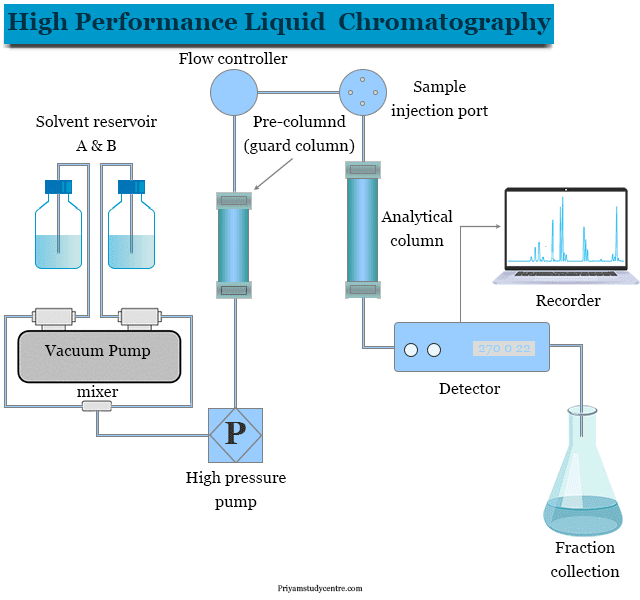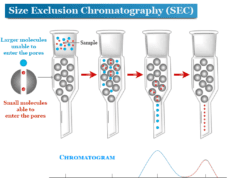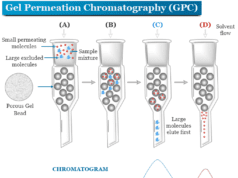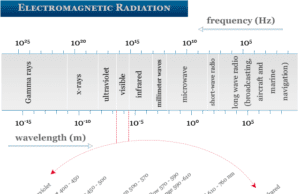High Performance Liquid Chromatography HPLC
High performance liquid chromatography (HPLC) principle is a modification of liquid chromatography used in analytical chemistry for the separation and identification of each component in a mixture. Liquid chromatography was initially less popular due to the slow technique for separation. High performance liquid chromatography (HPLC) is a rapid technique or instrument which works on all kinds of chromatographic systems such as adsorption, partition, exclusion, and ion exchange chromatography. After the discovery of high-pressure pump and ultraviolet-visible detector, the technique of liquid chromatography is termed high pressure chromatography or High performance liquid chromatography (HPLC). It is not a special class of chromatography.

Principle of High Performance Liquid Chromatography
The separation principle of high performance liquid chromatography works on the distribution of samples between a mobile phase or eluent and a stationary phase packed on the column. HPLC chromatographic peaks in the elution curve are affected mainly by flow rate, particle size, diffusion rate, and thickness of the stationary phase.
High performance liquid chromatography principle solved all the problems of classical methods of separation. From the point of view of speed and simplicity GLC system is better than the HPLC system. For the isolation of nonvolatile substances including inorganic ions and thermally unstable materials, the HPLC system works better.
HPLC Stationary Phase and Mobile Phase
There are two phases in the HPLC system like mobile phase and the stationary phase. We used a pump to control the flow rate of the mobile phase.
Mobile Phase
The mobile phase in the HPLC system is liquids that dissolve the analyzing samples.
Stationary Phase
The stationary phase in the HPLC system must be pressure stable. Usually, inorganic supports are stable at about 600 atmospheric pressure. Silica or alumina is best-bonded support because it need not be saturated with liquid phase and does not need a precolumn unit. When we used such a support medium, no contamination from the stationary phase occurred during sample isolation.
The ion exchange phase in the HPLC unit has a limited utility due to its compressibility. Pressure stable resins are available today which can withstand a pressure of 200 atmospheres.
The problems of stationary supports in exclusion chromatography are more complex than ion exchange resins. All types of gels used in columns are not pressured stable. Therefore, shrinking under pressure reduces the efficiency of separation in high-performance liquid chromatography.
How does High Performance Liquid Chromatography Work?
The instrumentation of a high performance liquid chromatography unit is given below the picture,
Generally, the efficiency of separation is better at low particle size. Reasonable flow rates in the HPLC system can be realized by high-pressure pumps. A high performance liquid chromatography system has the following main components,
- Solvent reservoir
- Sample injection port
- HPLC column
- HPLC detectors
- HPLC chromatogram
Solvent Reservoir
The solvent reservoirs A, B, and the vacuum pump is an important part of the HPLC system. The dissolved gases in the solvent can be eliminated by the vacuum pump.
A good HPLC unit has provision for more than two solvent reservoirs which release solvents into the mixing chamber at varying rates. The high pressure generated by pumping devices is not very dangerous because the solvents used in the HPLC unit are not easily compressible.
Sample Injection Port
The sample injection port is similar to that of gas chromatography. The support is made by KelF. A sample is drowned into the valve by means of a hypodermic syringe. Like gas chromatography, a self-sealing septum of silicon or Teflon is used in the sample injection port.
HPLC Column
Many HPLC instrument has a pre-column unit. The role of the precolumn is to remove impurities from the solvent to stop contamination.
The chromatographic or analytical column in high performance liquid chromatography instrument is made of glass or stainless steel.
- Glass is useful for pressure up to 600 psi.
- Generally, the column length in the HPLC unit is 15 to 150 cm with an internal diameter of 2 to 3 mm.
- The packing materials in the column are silica gel, alumina, or celite.
- The beads in the column are coated with a layer of porous materials such as silica gel, alumina, or ion exchange resin.
- Most separations in high performance chromatography are carried out at room temperature.
HPLC Detectors
One of the most important parts of high performance liquid chromatography instrumentation is the detector. Like GLC, we cannot use TCD, FID, and ECD types of detectors.
The choice of the detectors in high performance liquid chromatography depends upon the types of samples which we analyze. Ultraviolet-visible, infrared absorption, fluorescence, refractive index, conductance, and radioactive measurements are the basis of HPLC detection. Except for the refractive index type of detectors, all the other detectors are very sensitive in detection.
The most commonly used detector is less accurate than the spectrometric detector. Photometric detectors are less accurate than spectrometric detectors. For analysis of the organic functional group, UV radiation is most useful for analysis.
HPLC Chromatogram
In the high performance liquid chromatography system, a chromatogram can be used for the representation of separation or analysis of samples. A series of peaks is obtained in a computer or recorder which rises from the baseline along the time axis.
Different types of peaks are obtained for different compounds. The response should be 0.5 seconds or better for full scale to avoid distortion of rapidly eluting peaks. Chat speed in the HPLC system should be adjustable.
Uses of High Performance Liquid Chromatography
High performance liquid chromatography technique is mainly used for the separation and analysis of samples in the pharmaceutical and pesticide industries. In liquid-liquid chromatography with the HPLC system, separation of moderately polar substances is possible. We also used a combination of ion exchange and HPLC on porous layer beads (PLB).
Some applications of the high performance liquid chromatography technique are given below,
- A mixture of sugars containing fructose, glucose, sucrose, maltose, and lactose can be separated by the HPLC technique in the presence of a refractive index detector.
- Different types of drugs have been separated on Mercosorb SL-100 coated with 0.6M picric acid at pH 6.0 with chloroform (mobile phase) in ion-pair chromatography. We used a UV detector to complete this operation. The above HPLC technique works mostly on drugs like scopolamine, ergotamine, and hyoscyamine.
- In the cation exchange HPLC technique, a urinary extract containing metabolite and antipyrine has been separated on zipax SCX with borax buffer at the pressure of 100 psi.
- Protein has been separated by size exclusion HPLC technique. Proteins can be separated on column TSK 2000SW with phosphate buffer at pH 6.5 in the presence of mobile phase 0.2M sodium sulfate solution. We commonly used a UV detector for the separation or analysis of protein samples in size exclusion high performance liquid chromatography (HPLC) system.








